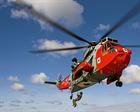Culdrose rescue squadron makes three rescues in St Austell in one day
On the 30th of September the duty crew of 771 Naval Air Squadron (NAS) had one of the busiest days the Squadron has had in recent weeks. The crew which included Lieutenant Mark Barber, Kapitänleutnant Steffan Volkwein, Lieutenant Commander Richie Full and Chief Air Crewman Dave Rigg QGM, spent a day in the skies above St Austell answering emergency calls from members of the public attending three separate calls all within the vicinity of the town.
For 771 NAS, the Royal Navy’s Search and Rescue Squadron based at Royal Naval Air Station (RNAS) Culdrose, everyday is different and the fact that three calls came from St Austell over the space of five hours was certainly unusual.
At 11:15 AM the helicopter on call for any emergencies that day was taking part in a cliff rescue exercise in the St Austell area, helping to hone the crew’s skills needed for such a rescue. At the same time an Emergency Position Indicating Radio Beacon (EPIRB) had been activated on a yacht in the local area signalling that immediate assistance was required. Putting their training exercise on hold, the helicopter raced towards the last known position of the yacht. When they arrived the crew found the yacht abandoned and floating with no one at the helm. After commencing a visual search a mile around the yacht to try to locate the crew, a position was given to the helicopter that had been received from a Personal Locator Beacon (PLB) on a crew member. Using the position received, the 771 NAS crew found a lone man in the water. Chief Air Crewman Dave Rigg was then winched down to recover the sailor on to the helicopter. Upon his rescue it became apparent that he was the only person onboard the yacht so the helicopter made its way to Treliske Hospital in Truro to drop off the casualty.
The time now was 12:05 PM, but before the crew had a chance to congratulate themselves on a job well done another job had come though. A 22 year old man had fallen off of his Motor cross bike near St Austell and had serious spinal injuries. Taking off from the hospital, the helicopter made its way over to the injured man who was being looked after by paramedics at the scene. When they arrived, Dave was once again winched down to the casualty this time with a stretcher. Once the injured man was secure on the stretcher he was winched up and the helicopter made its second visit to Treliske Hospital in the space of an hour.
After a brief respite back at RNAS Culdrose, the crew were once again called into action and again in the St Austell area! A couple and their dog had become cut off on a spit of land by an incoming tide at Gribben Head and were in danger of being washed out to sea. The helicopter arrived on scene at 4:45 PM and with high tide fast approaching the crew would soon run out of time to get them safely on board. For the third time that day Dave was winched down to recover the two people and their dog before dropping them off safely at a local rugby pitch. This is something Dave now takes in his stride as he has completed over 480 rescues and has been working with Search and Rescue since 2001 during which time he has been recognised for the role he has played in rescues, including being awarded the Queen’s Gallantry Medal in 2010.
“This is exactly why we are on call” said Lt Cdr Andy Watts, 771 NAS Observer and Medic, “To respond swiftly, provide the best medical care and able to then transfer the casualty to the nearest suitable medical facility. Of course, not all our call outs require medical care but we respond to each and every shout in exactly the same manner and provide equally high levels of professional care and attention.”

